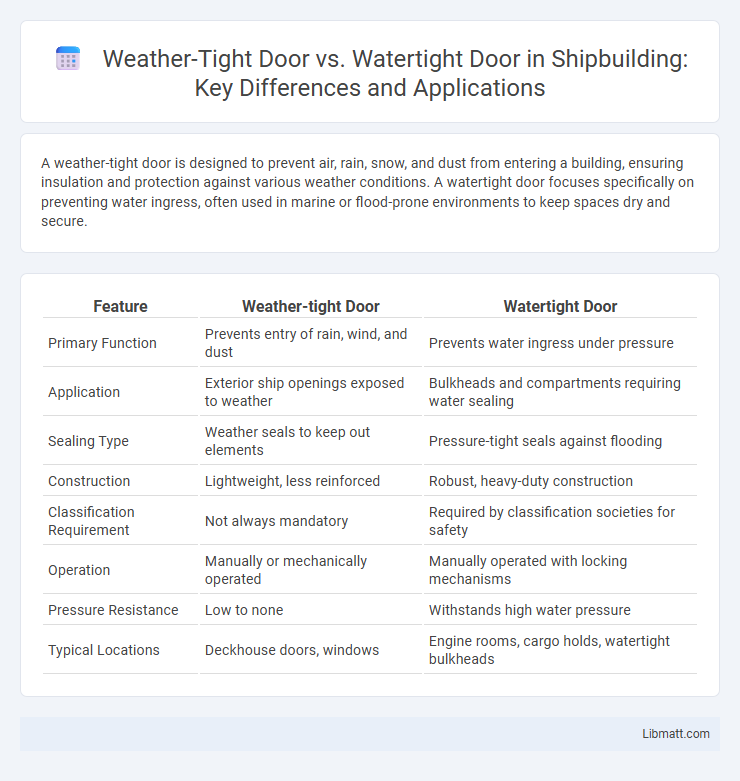A weather-tight door is designed to prevent air, rain, snow, and dust from entering a building, ensuring insulation and protection against various weather conditions. A watertight door focuses specifically on preventing water ingress, often used in marine or flood-prone environments to keep spaces dry and secure.
Table of Comparison
| Feature | Weather-tight Door | Watertight Door |
|---|---|---|
| Primary Function | Prevents entry of rain, wind, and dust | Prevents water ingress under pressure |
| Application | Exterior ship openings exposed to weather | Bulkheads and compartments requiring water sealing |
| Sealing Type | Weather seals to keep out elements | Pressure-tight seals against flooding |
| Construction | Lightweight, less reinforced | Robust, heavy-duty construction |
| Classification Requirement | Not always mandatory | Required by classification societies for safety |
| Operation | Manually or mechanically operated | Manually operated with locking mechanisms |
| Pressure Resistance | Low to none | Withstands high water pressure |
| Typical Locations | Deckhouse doors, windows | Engine rooms, cargo holds, watertight bulkheads |
Understanding Weather-Tight and Watertight Doors
Weather-tight doors are designed to prevent the ingress of air, rain, and dust, ensuring insulation and protection against varying weather conditions. Watertight doors provide a higher level of sealing, specifically engineered to prevent water penetration, making them essential for marine vessels, flood-prone areas, or industrial environments exposed to significant water pressure. Understanding the differences helps you select the appropriate door that matches your environmental and safety requirements.
Key Differences Between Weather-Tight and Watertight Doors
Weather-tight doors are designed to prevent air, rain, and dust from entering spaces, providing insulation against various weather conditions, while watertight doors are engineered to withstand complete water pressure, preventing water ingress in flooding or marine environments. Weather-tight doors typically feature robust seals and weather stripping for protection against wind and moisture, whereas watertight doors incorporate gasket systems and locking mechanisms to maintain an airtight seal under submersion. Understanding these key differences ensures you select the appropriate door type for your building or vessel's specific environmental requirements.
Functions and Purpose of Weather-Tight Doors
Weather-tight doors are specifically designed to prevent the infiltration of air, dust, and water spray, ensuring a controlled environment inside industrial or marine settings. Their primary function is to maintain atmospheric pressure and reduce energy loss by sealing tightly against weather conditions such as wind and rain. Unlike watertight doors, which are engineered to withstand direct water pressure and prevent flooding, weather-tight doors focus on protection against environmental elements while allowing some degree of moisture resistance.
Functions and Purpose of Watertight Doors
Watertight doors are specifically designed to prevent water from entering confined spaces, ensuring the safety and integrity of vessels and offshore structures during flooding or heavy seas. Unlike weather-tight doors, which primarily protect against wind, rain, and dust, watertight doors maintain compartmentalization to minimize water ingress and enhance buoyancy and stability in emergencies. Your choice of watertight door impacts the overall safety and compliance of marine and industrial environments where water intrusion poses significant risks.
Applications of Weather-Tight Doors in Marine and Industry
Weather-tight doors are crucial in marine environments, ensuring airtight compartments that prevent the ingress of wind, rain, and airborne contaminants while maintaining structural integrity under varying atmospheric pressures. In industrial settings, these doors provide robust seals against dust, fumes, and temperature fluctuations, enhancing safety and operational efficiency in facilities such as chemical plants, refineries, and HVAC-controlled environments. Their ability to withstand harsh conditions while preserving internal environments makes weather-tight doors indispensable for maintaining controlled atmospheres and regulatory compliance.
Applications of Watertight Doors in Ships and Offshore Structures
Watertight doors are essential in ships and offshore structures to prevent water ingress during heavy seas or flooding, ensuring compartmental integrity and crew safety. These doors are designed to withstand high hydrostatic pressure, making them suitable for bulkheads and escape routes in marine environments. Your choice of watertight doors enhances the overall structural resilience and operational safety of vessels and offshore platforms.
Construction and Design Features of Weather-Tight Doors
Weather-tight doors are constructed with robust seals and reinforced frames designed to prevent air, dust, and moisture infiltration, ensuring optimal insulation and energy efficiency. Their design often includes durable materials such as steel or aluminum combined with weather-resistant gaskets and tight-fitting edges to withstand harsh environmental conditions. Your choice of a weather-tight door guarantees enhanced protection against weather elements without necessarily providing the complete water sealing required for watertight doors.
Construction and Design Features of Watertight Doors
Watertight doors feature reinforced steel construction with robust sealing mechanisms designed to withstand high water pressure and prevent water ingress during flooding or submersion. They incorporate gasketed edges and locking systems that create a tight seal, ensuring the integrity of bulkheads in marine or industrial environments. Your choice between weather-tight and watertight doors should consider these specialized design features essential for protecting against liquid penetration.
Maintenance and Safety Considerations
Weather-tight doors require regular inspection of seals and hinges to prevent air leaks and energy loss, ensuring indoor climate control and reducing utility costs. Watertight doors demand rigorous maintenance of gaskets and locking mechanisms to prevent water ingress, crucial for protecting interior spaces from flooding and structural damage in marine or flood-prone environments. Both door types prioritize safety, with weather-tight doors enhancing thermal protection and watertight doors maintaining structural integrity during water exposure.
Choosing the Right Door Type for Your Needs
Weather-tight doors are designed to prevent air infiltration and protect against wind, rain, and temperature fluctuations, making them ideal for exterior residential and commercial applications. Watertight doors provide a higher level of protection by preventing the passage of water under pressure, commonly used in marine environments, flood-prone areas, or industrial settings requiring strict water resistance. Selecting the appropriate door depends on exposure conditions, with weather-tight doors suited for general weather protection and watertight doors essential for environments where water intrusion could cause significant damage or safety hazards.
Weather-tight door vs watertight door Infographic

 libmatt.com
libmatt.com